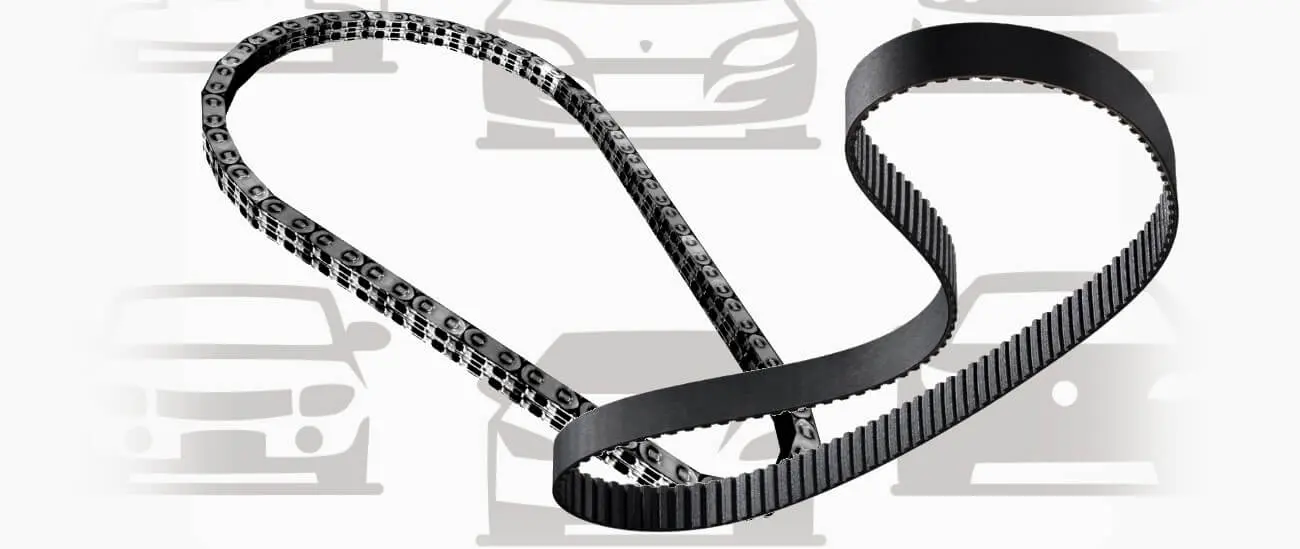Typically, every component in your vehicle’s engine works in perfect synchrony for a functional and smooth operation. The timing components, such as a timing belt, works with the crankshaft and camshaft to keep the pistons and valves functioning as they should.
No doubt, timing belts and timing chains do the same thing. But are they the same thing? We go a little bit deeper for your benefit.
The Basics
The timing belts and the timing chains are the timing components in the engine. But what do they do? Why are the timing components crucial?
The camshaft regulates the valves in the engine to let air and fuel in and out, while the crankshaft moves the pistons. This is mechanical timing.
The synchrony of the camshaft and crankshaft functions is critical, and damage to the valves, engines, pistons and other components in the engine can occur if the mechanical timing is off.
Timing belts or timing chains ensure that every turning is precise for harmonization. The engine is so reliant on the timing component that it would experience a significant loss in power, seize or stop running if the component is faulty.
For a long time, the timing gears or timing chains rotated the camshaft in overhead valve (OHV) engines and many overhead cam (OHC) engines in the ’80s. Timing belts entered the scene in the mid-’80s and ’00s. They are only returning to the fore in recent times.
Normally, you cannot tell the type of timing component in your car unless you disassemble the engine. Timing gears and the timing chains, concealed by hard metal covers for lubrication, are hard to access.
Even though timing belts do not need similar lubrication to timing gears, they need protection. Unsealed plastic covers usually protect these timing belts and are one of the ways you can distinguish between the two. Regardless, look up the components for confirmation. It’s important.
Which is Better Between the Timing Belt and the Timing Chain?
Different car models or brands prefer one type of timing component over another. But why is this so? What do these vehicles stand to benefit by choosing one over another?
Let’s explore the answer together.
Timing Belts
These timing components are quiet and light but not very durable. Timing belts, which are less expensive to produce, are rubber-based and wear out easily. The component is normally outside the engine, and they tend to dry out and develop cracks over time. Timing belts need to be swapped after some time.
The wear-out process accelerates when there are oil or coolant leaks. When there’s trouble with the timing belt, the cogs crack and break off. This causes a slight difference in the belt movement, which changes the mechanical timing.
Unfortunately, there are no clear-cut signs that the timing belt is having trouble and going out. It mostly happens suddenly without warning. Therefore, it is imperative to change this engine part after passing a particular period or mileage.
Most brands recommend replacing timing belts after every 95,000 km to 170,000 km. Modern vehicles can go as much as 170,000 km before requiring replacement, but it’s not the case for older ones. Replace the timing belt of your older car at 95,000 km.
The shock absorption properties of timing belts are more appropriate for NASCAR and other high-revving engines.
Most mechanics advice replacement of the timing belt at the time when the water pump goes out. The belt is usually removed to access the water pump for replacement, and this is the time that you can kill two birds with one stone.
Timing Chains
Timing chains, the first to be introduced in the 1960s, are a bit more complicated than timing belts. They are constructed of metal, are heavier and last much longer. Timing chains do not have a recommended replacement interval unless there is an issue. Regular oil changes are mostly sufficient to prevent stretching, premature wear and failure.
Keep in mind that the timing chains rely on oil viscosity. Lighter oils will reach every part of the engine components that need lubrication.
Timing chains are more practical, where there is a need for quietness and strength. At least they are quieter than timing gears. These chains are making a comeback, with improvements in vibration and noise reduction.
Timing Gears
Timing gears are the most accurate, strong and last a long time. Unfortunately, they are the noisiest, with a whine similar to a supercharger.
The timing gears’ strength and precise timing make them appropriate for high compression engines, such as diesel engines. However, their unique sounds are sometimes similar to the knock sensor vibrations of modern EFI systems, which can trick the system.
Initially, auto manufacturers used timing gears and timing chains because that was what was available at the time. They only briefly shifted to timing belts for their quieter operation and convenience. However, the timing belts were found to be quite problematic.
Broken timing belts have caused valve crashes and damage to interference engines.
The interference design in modern engines allows them to breathe better. This improves its fuel economy, power, efficiency and emissions. Automakers are gradually shifting to more durable and stronger timing chains and timing gears to prevent valve crashes.
The choice between the different timing components is mostly dependent on the engine requirement at the time, pretty much. Timing chains and timing gear were most preferred by automakers, but the customers demanded something quieter, which timing belts delivered. Today, regulations require efficiency and auto buyers are more interested in longevity, and therefore the preference for timing chains.
Need to change your timing belt or chain?
Contact mechanic 24hr for routine maintenance and repairs. We will also help with more information on timing belts, timing gears or timing chain replacement should you need it. Don’t hesitate to contact us today.


